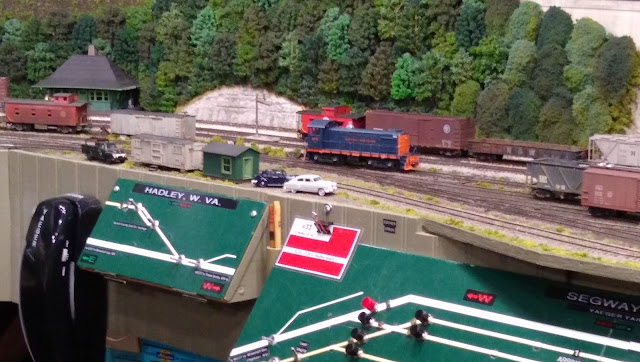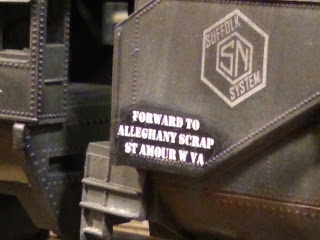With a robust car fleet in service, and all that forest still needing to be planted, the last thing I should be working on is more boxcars.
"But Mama - that's where the fun is!"
-- Manfred Mann / Bruce Springsteen
I can't help it - the variety and condition of aging cars that survived WWII is just mesmerizing. My friend Jim Rollwage (UP-Denver Pacific) got me deeply hooked on the postwar freight car fleet, by sharing a book called, oddly enough, The Postwar Freight Car Fleet. (NMRA, 2006).
In this tome, we in the modern world are treated to a deep dive on the subject by an unknown railfan, who spent 1946 and '47 taking pictures in and around Harrisburg, Pa., of... freight cars. Just... freight cars. Oh, my. You might think you couldn't possibly care, that far down a rabbit hole, but you just... can't put it down. It's a snapshot of a point in time in the classic era, and no two car classes are the same on different railroads!
So I had a couple of oddball cars on hand that I'd wanted to maybe work into the fleet at some point... Reading through this book I found credible examples of each, and the bug bit to get those into SNR paint. It happens that they're both double-door cars originally built for automobile service, but that wasn't necessarily important. What was important, was that they were wood. They just don't build 'em like they used to, you know.
DOUBLE-SHEATHED 40' CAR #20943
In 1921, the Railway placed an order for 850 USRA-design 40' double-sheathed cars, which became the 20xxx series. That order also included another 100 double-door cars intended for automobile service - a class of specialized equipment then just in its infancy. The auto cars were tacked onto the end of the series, in the 20900-20999 range.
By the late 1930's, the automobiles rolling out of Detroit's factories had gotten long and fat, across the board. The 40' boxcars designed to carry little Model T's just weren't suited to the trade anymore. So most of the 209xx class were taken out of automobile service, and rebuilt for general merchandise. Most received Dreadnaught steel ends in place of wood, and a power hand brake. Steel roofwalks and/or Youngstown doors were also applied as needed, although our feature car was bypassed for those upgrades. Repaintings included the large new solid herald, AAR-standard reporting marks, and sans the "Railway".
Many railroads also removed the extraneous left door as part of their overhaul of such cars, but the thrifty Dutchmen in Suffolk found such an expense frivolous. And by retaining their double doors, this class turned out to be ideal for handling the crated Jeeps pouring out of Toledo during WWII, headed for the Atlantic.
This one is actually an old AHM ready-to-run car, complete with all the trainset accoutrements including truck-mounted horn-hook couplers, and garish, impossible paint.
(And hey, how about those roller-bearing trucks, too!) You might say "Jeese, why would you bother with such junk, when there are so many
good cars out there?" And you'd be right - except that:
- At its core, this is a fairly uncommon model of a not-so-uncommon prototype,
- Bargain-hunting is all part of the fun (I picked this car up for 3 bucks!),
- I enjoy the challenge of adapting oddballs, and
- I had one of these cars as a teenager that I painted and decaled for Northern Pacific, so there's some nostalgia at work.
What always bugged me most about the AHM cars, though, was that enormous, blank side sill under the doors. Yes it was common to reinforce the sill on double-door cars, especially wooden ones, but not often to such a huge degree. Some research in "the book" revealed an almost exact match for the car, with only a minor reinforcement under the doors:
I was thrilled to find this reference - the AHM car's proportions really favor it, once that huge sill is trimmed away. And, it's sporting much newer Dreadnaught ends too, like the AHM. Interestingly though, its original vertical-staff hand brake was retained in the rebuild, something rarely seen on new ends. While I loves me some vertical brake staff, skiving off cast-on details from corrugations was way beyond 80/20 for our 3-buck model. So we're saying the Suffolk shops upgraded the hand brake too.
Ironically, I was already finished with the car and looking at pictures of it for this post, when I saw up close that foot-thick steel roofwalk and tree-limb-diameter stirrups. You know that Clint Eastwood "Eeeuughgh" face? Like when he's looking at carnage, usually of his own making?
Yeah that. So it was back to the workbench to un-finish the car. I made a new running board, wooden this time, out of Evergreen strip, and replaced the cast stirrups with brass rod. Still not perfect, but much better, I think.
I'm sure there's a beautiful resin kit out there for a similar car, which I'll enjoy building someday to replace this guy. But there's a lot of forest I should really be working on first.
SINGLE-SHEATHED 50' CAR #22677
The larger car is from an order for 200 cars built in 1928. SNR had assigned single-sheathed, steel-end cars to the 22xxx series starting in 1925, and this subclass claimed the 22600-22799 range.
These cars were the cutting edge of auto-box technology at the time, with 10' 6" ceilings, fixed racks, and end doors - made for handling all those big, bourgeois touring cars roaring out of Detroit in the Roaring Twenties. Model A's could still squeeze through the doors in the 40-footers, but your modern Packards, Cadillacs, and the like, needed newer, bigger accommodations.
Like most such cars, SNR's retained their auto racks and end doors throughout WWII, and resumed automobile service when production returned to civilian vehicles. Some even lived to carry cars with tailfins, although they were also regularly loaded with furniture, lumber, and all manner of non-automotive freight, too. The SNR class received repaints in 1946-47, but few modifications.
I remember being amazed when I first discovered these cars, as I had always associated exposed Z-bracing with short, low-ceiling, single-door cars like Train-Miniature's. Who knew! It was inevitable that the SNR would need an example or two.
Our feature car is an out-of-the box MDC model with SNR lettering. Those models also have a big, unsightly sill reinforcement under the doors like the AHM did - which, as it turns out, none of the numerous prototype examples in "the book" have.
I had intended to slice those sills down too, but MDC did a nice job integrating them into the frame, with full-depth cross members behind them, and rivet detail too. I still might do the conversion one day, but it will be a bit more involved than the 10-minute hack job on the AHM. For now, let's get it rolling!
Our new friends high-tail it for Suffolk on SM-8, amid a bevy of SNR boxcars from the 1920's.







































